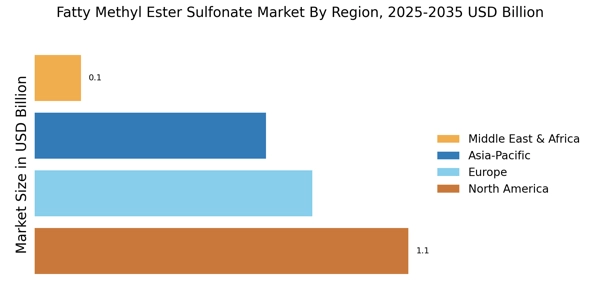Regulatory Support
Regulatory frameworks that promote the use of environmentally friendly surfactants are likely to bolster the Fatty Methyl Ester Sulfonate Market. Governments and regulatory bodies are increasingly implementing policies that encourage the adoption of sustainable chemicals, which may include fatty methyl ester sulfonates. Such regulations not only facilitate market entry for these products but also provide incentives for manufacturers to innovate and invest in greener technologies. As a result, the market could witness accelerated growth, as companies align their product lines with regulatory expectations. This supportive environment may also enhance consumer confidence in fatty methyl ester sulfonates, further driving their adoption across various sectors.
Technological Innovations
Technological advancements in the production processes of fatty methyl ester sulfonates are likely to enhance the efficiency and reduce the costs associated with their manufacturing. Innovations such as improved catalytic processes and the use of renewable feedstocks are becoming increasingly prevalent in the Fatty Methyl Ester Sulfonate Market. These developments not only streamline production but also contribute to the overall sustainability of the products. As a result, manufacturers are expected to experience lower operational costs, which could translate into more competitive pricing for consumers. Furthermore, the integration of automation and digital technologies in production facilities may lead to higher quality control standards, thereby increasing consumer trust and market penetration.
Sustainability Initiatives
The increasing emphasis on sustainability appears to be a pivotal driver for the Fatty Methyl Ester Sulfonate Market. As consumers and industries alike prioritize eco-friendly products, the demand for biodegradable surfactants, such as fatty methyl ester sulfonates, is likely to rise. This shift is evident in various sectors, including personal care and household cleaning, where manufacturers are seeking alternatives to traditional petrochemical-based surfactants. The market for fatty methyl ester sulfonate is projected to grow at a compound annual growth rate of approximately 5% over the next few years, reflecting the broader trend towards sustainable practices. Companies that align their product offerings with these sustainability initiatives may find themselves at a competitive advantage, potentially capturing a larger share of the market.
Consumer Awareness and Demand
Growing consumer awareness regarding the benefits of using eco-friendly and biodegradable products is a significant driver for the Fatty Methyl Ester Sulfonate Market. As consumers become more informed about the environmental impact of their purchasing decisions, there is a noticeable shift towards products that are perceived as safer and more sustainable. This trend is particularly evident in the personal care and household cleaning sectors, where consumers are actively seeking out products that contain fatty methyl ester sulfonates. The increasing demand for such products is likely to encourage manufacturers to expand their offerings, thereby contributing to the overall growth of the market. As a result, the Fatty Methyl Ester Sulfonate Market may experience a robust increase in sales and market presence.
Diverse Industrial Applications
The versatility of fatty methyl ester sulfonates is a notable driver for the Fatty Methyl Ester Sulfonate Market. These compounds are utilized across a wide array of applications, including detergents, personal care products, and agricultural formulations. The ability of fatty methyl ester sulfonates to function effectively in various formulations makes them attractive to manufacturers seeking to optimize product performance. For instance, in the detergent sector, they are valued for their excellent cleaning properties and compatibility with other ingredients. This broad applicability is expected to sustain demand, with the market projected to reach a valuation of several hundred million dollars in the coming years, driven by the continuous expansion of end-use industries.


















Leave a Comment